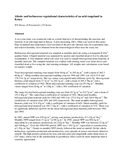| dc.description.abstract | A two-year study was conducted with an overall objective of characterising the structure and function of an arid rangeland in Kenya. A plot measuring 100 x 100m was used for this study. Data on rainfall and temperature were recorded at the plot site whereas data on evaporation rates and relative humidity were obtained from the meteorological office near the study site.
Herbaceous aboveground material was sampled at monthly intervals using a rectangular 0.25m2 quadrat frame. Clipped material was separated by species and classified dead or live by physical examination. A 5cm diameter metal soil corer was used to sample belowground plant material, at monthly intervals. The sampled material was washed with running water over 2mm sieves and classified dead or live using the vital staining technique. All weights and calculations were based on organic weight.
Total aboveground standing crop ranged from 84.6g m-2 to 295.4g m-2, with a mean of 162.3 60.6g m-2. Mean monthly aboveground standing crop for 1992 and 1993 was 142.8 53.8 and 178.5 63.3g m-2 respectively. The two values were significantly different (p<0.10). Aboveground biomass yield ranged from 17.7g m-2 to 242.7g m-2, with a mean of 104.3 58g m-2 and a coefficient of variation of 58%. Mean aboveground standing crop was 59 24g m-2. Monthly values ranged from 28.8g m-2 to 120g m-2, with a 38% coefficient of variation.
The range for total belowground standing crop was from 83.3g m-2 to 232.7g m-2, and a mean of 155.2 46g m-2. The values had a coefficient of variation of 30%. Mean total monthly belowground plant material yield for 1992 and 1993 was 137.6 41g m-2 and 169.9 46g m-2. The coefficients of variation were 59% and 28% respectively. The mean monthly belowground biomass yield was 51.6 33g m-2 with a coefficient of variation of 64%. Mean monthly yield for belowground dead material was 103.7 32g m-2, with a coefficient of variation of 31%. There was no significant difference (p>0.01) in the mean belowground dead material yield between 1992 and 1993.
In 1992, annual NPP was 439.2g m-2, giving a net primary productivity of 1.22g m-2day-1. Monthly NPP ranged from 17.2g m-2 to 90.1g m-2. In 1993, annual NPP was 944.5g m-2, equivalent to a net primary productivity of 2.62g m-2day-1. Monthly NPP was between 27.4g m-2 and 548.6g m-2. Over the 19921993 period, NPP was 1 383.7g m-2, equivalent to a productivity of 1.92g m-2day-1. Trends in monthly NPP closely followed the trend in rainfall. On the whole, herbaceous vegetation production and productivity were episodic in nature and closely linked to rainfall. The high primary productivity puts arid and semi-arid rangelands under sharp focus as CO2 sinks, whose role in the amelioration of greenhouse effect could be more important than is currently appreciated. | en |

